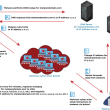Explore top cybersecurity risks in crypto, including phishing, ransomware, and MitM attacks. Learn practical tips to safeguard your digital assets now.
Cryptocurrencies have recently increased in popularity, with more alternatives launched every day. The first cryptocurrency ever developed was Bitcoin, which inspired plenty of other cryptocurrencies to be created and make new waves in the world.
Even though there are various other notable examples in the crypto space, Bitcoin still has the number one position and represents the largest cryptocurrency by market cap. This has made a lot of individuals search for the best crypto exchange from where to buy Bitcoin to add it to their portfolios.
Cryptocurrencies have brought several advantages to the world, as they have finally offered another solution to fiat money, integrating decentralization into the world. However, even if the popularity of cryptocurrencies has many advantages, it also has a major downside. For example, the price of the major digital coins has increased greatly, and this has attracted a lot of hackers who are trying to steal the funds of innocent people.
So, the crypto space is subjected to various threats, and because of that, before investing, it is imperative to adopt a more cautious approach, as, in this way, you can protect your crypto funds from malicious actors.
To protect your crypto assets, you must know the most common cybersecurity risks in the crypto space. In this way, you can avoid them and protect yourself against everything that might appear on the horizon. To help you a little in this process, we will explore together the most common cybersecurity threats in the crypto ecosystem. Keep reading to discover more.
Phishing threats
One of the most common ways hackers try to steal information is through phishing attacks. In this cybersecurity threat, a malicious actor can use plenty of online means to try to steal information, such as texts, emails, and websites. The hacker will then try to fool users into clicking on this misleading information. But if individuals do that, their crypto funds can be stolen, as these clicks can reveal seed phrases or private keys.
One of the most common ways hackers want to steal information is when they pretend to be a crypto exchange; in this way, they think they have a bigger chance of making users click on the sent links.
Unfortunately, especially when cryptocurrencies started becoming more popular, many people lost access to their crypto accounts because they fell prey to this kind of scam. This is why anyone wanting to increase the chances of keeping their crypto accounts secure should take measures to help them prevent phishing scams.
One of the best cybersecurity measures for this is to use two-factor authentication (2FA), which can increase resilience against these online threats. Another important security action is to double-check before clicking on a link or email to ensure that the offered details are veritable and that there is no chance of a scam.
Ransomware attacks
Ransomware attacks are also very popular in the crypto industry, and these threats contain malicious malware that can encrypt files that individuals use to access their crypto funds, such as crypto wallets or their private keys.
These attacks will make the data on these files unreadable, and for the owner to have access to these files again, they need to pay in return. And as we’re talking about crypto accounts, in most cases, these malicious actors ask for payment with cryptocurrencies to receive access to their accounts again.
One of the best ways to reduce becoming a victim of these attacks is to use a cold wallet instead of one that functions with internet connectivity or to maintain a regular backup. Another great solution to avoid these cybersecurity attacks is to be cautious before clicking on something, like a link or an email, especially if an unknown or unidentified person sends it.
Malware attacks
Malware attacks can also be dangerous to everyone who holds significant crypto funds. In these attacks, a malicious actor tries to compromise a crypto wallet or infect gadgets to steal cryptocurrencies. A very common malware attack used in the crypto landscape is crypto-jacking, which infiltrates into devices and then uses computing power to mine digital assets.
In most cases, this leads to high electrical costs, financial losses, or damage to device performance. One of the best measures to protect against these attacks is installing anti-virus software and downloading everything needed only from official or reputable sites.
Man-in-the-Middle (MitM)
Man-in-the-Middle (MitM) attacks happen when a hacker wants to come between the communication between a crypto exchange and a user, with the final goal of stealing private keys and login credentials. Unfortunately, these attacks can steal crypto funds because hackers can discover sensitive crypto information, like private keys or login credentials.
In this type of attack, the crypto transactions can be sent directly to the hacker’s wallet instead of the right recipient. This is why it is better to refrain from paying with cryptocurrencies when using public WiFi, as in this way, you might encourage your crypto funds to be stolen.
Zero-day attacks
Zero-day attacks are also very common, where hackers exploit every vulnerability they find in crypto platforms, such as hardware wallets or crypto software. If developers don’t discover these vulnerabilities on time, hackers will have everything they need to steal the crypto funds of innocent people. And until developers notice the potential vulnerability, the malicious actors have enough time to steal what they want, bringing enormous losses to individuals worldwide.
The bottom line
Industries from all around the world can deal with hackers who are trying to steal information, but these threats have become even more prevalent in the crypto sphere because of the popularity of digital assets. This is why malicious actors see cryptocurrency as the perfect target, which is why recent attacks on digital coins have become so common.









